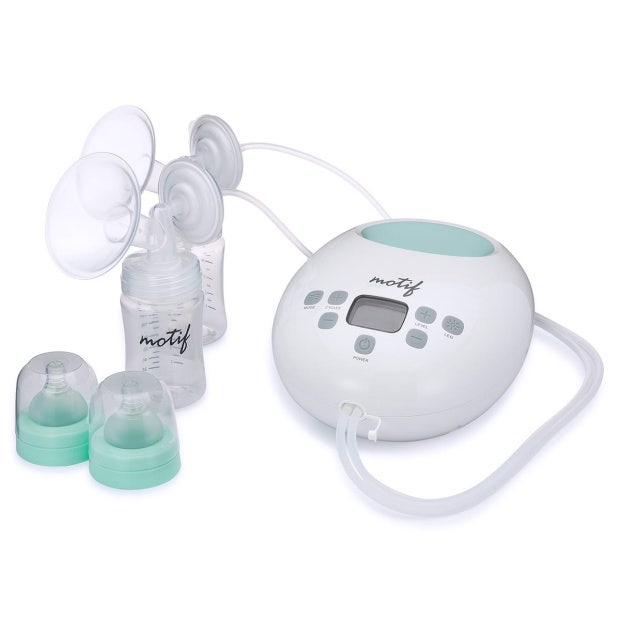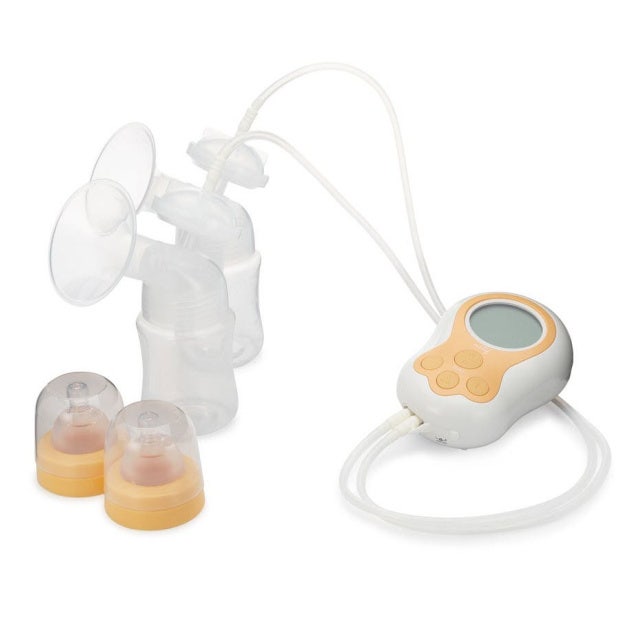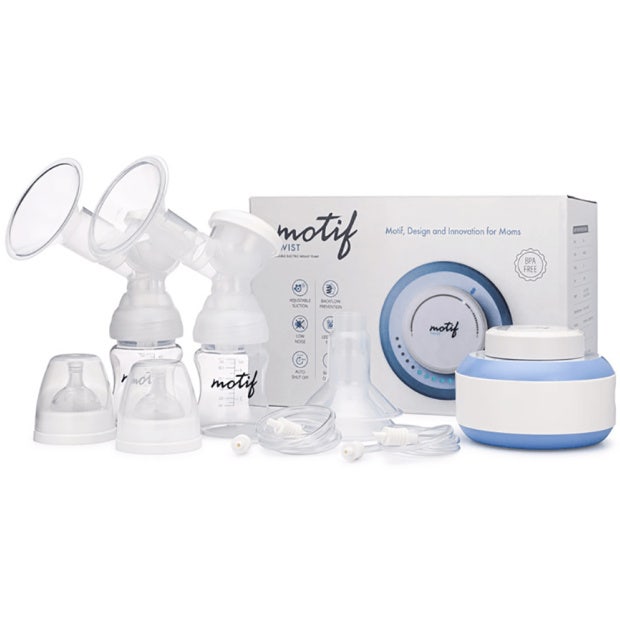How To Choose The Perfect Breast Pump As A New Mom
Moms get to decide what is best for their baby.
 pyrozhenka / Shutterstock
pyrozhenka / Shutterstock Having a baby means making sure they are happy, comfortable and well-cared-for. A big part of that is ensuring that they receive enough nutrients, and many utilize a breast pump to get milk safely and effectively.
“Whether the reasoning is due to preferences, sharing the opportunity with a partner, the ability to work away from the home and still provide breast milk, or for feeding obstacles — such as the baby being unable to latch or latch effectively for various reasons — lactating mothers have options!” says Ashley Georgakopoulos, Motif Medical Lactation Director and International Board Certified Lactation Consultant.
In fact, Motif Medical designs products for mothers, including breast pumps and maternity compression garments.
Motif Medical is dedicated to offering the very best products that help families and moms stay happy and healthy, get more milk, bond with the baby, support their body, and remain comfortable.
In addition to their products, the Motif Medical Blog is also helpful in explaining different features of pumps, why they are necessary, and how lifestyle choices affect pumping. For example, one recent blog post covered steps moms can take if they are taking CBD or other medications while breastfeeding, which is important information for any mom to know!
Types Of Breast Pumps
When considering which pump is best, the most critical question you should ask is: Why am I pumping?
“Am I going to be separated from the baby frequently and for long periods? Do I need an occasional break from breastfeeding? Am I having issues with milk supply?" asks Jennifer Horne, an IBCLC with The Lactation Network. "You should also think about how long you intend to pump, your baby's age, need for mobility, insurance coverage, and financial situation”
Breast pumps typically fall into three categories. According to Home, “There are pumps that are meant for occasional use (a few times a week), meant for regular use (daily), and meant for mothers who may not have an established milk supply and whose baby is less than two months old.”
Electric Breast Pumps
An electric breast pump plugs in, and generally sustains better suction strength and duration. “If pumping for larger volume needs, this is the route to go,” says Georgakopoulos.
Electric breast pumps work by placing the breast shield on one or both breasts, and pressing a button on the machine, which triggers a rhythmic vacuum suction.
“They get their power from batteries, rechargeable batteries, or wall plug-ins. They are more convenient than manual pumps since you do not have to rely on your energy,” adds Horne.
However, not all-electric pumps are recommended for regular, daily use.
Manual Breast Pumps
Manual breast pumps are self-powered through squeezing a handle or the pump itself to provide gentle suction. These pumps are also great for bringing in-tow.
“This pump is great for removing excess milk from engorgement, as well as clogs. It can also be used to prime the nipple to aid in the baby latching,” advises Georgakopoulos.
Battery-Operated Breast Pumps
Rather than plugging this one in to charge, as the name suggests this pump runs on batteries. This means there's plenty of versatility in pumping locations, back-up or emergency situations, as well as certain suction strengths.
Single-Electric Breast Pumps
For the mom who prefers to take her time when pumping, a single-electric breast pump means that only one breast can be pumped at a time, and may take a bit longer. However, these pumps tend to be a little less expensive.
Double-Electric Breast Pumps
Double-electric breast pumps have the capacity to pump both breasts simultaneously.
Adds Georgakopoulos, “It's great for time effectiveness. Premium brand pumps are designed to not lose suction strength levels when divided or sharing suction power for pumping both breasts.”
Wearable Breast Pumps
A wearable breast pump is hands-free and allows moms to choose from a variety of pumping locations. It's a great option for those who respond well to pumping, regardless of suction strength maximization.
“It may sacrifice suction strength or duration in exchange for convenience,” cautions Georgakopoulos.
Hospital-Grade Breast Pumps
Hospital-grade pumps have the strongest suction, and are specifically designed to bring out and maintain milk supply. “They are called hospital-grade because of the stronger vacuum strength," says Horne.
Some are for personal use (one user only), or multiple users, but are often recommended in the hospital (in the maternity ward) if a baby is premature or a mom is having other breastfeeding difficulties early on.
“Multiple user, hospital-grade pumps are designed to be used safely and reliably by numerous users,” Horne advises. “These pumps are also recommended if you are exclusively pumping, had previous breast surgery, have conditions that may affect milk supply, or are inducing lactation. Although these pumps are highly durable, they tend to be bigger and more expensive.”
Motif Medical offers various electric breast pumps, each with its own unique specifications.
1. Luna Double Electric Breast Pump

The Luna Double Electric Breast Pump offers a closed system with backflow protection so the motor and tubing stay clean, which helps prevent contamination. It also has a rechargeable battery that lasts 2+ hours — perfect for a commuting mom.
As a double electric breast pump, the Motif Luna is lightweight, easy to use, and hospital grade, and it's so quiet you can pump as the baby sleeps. It also boasts built-in LED night light with three different settings, perfect for finding a setting that works for you and your baby's unique needs; a timer and auto shut-off; expression and massage modes.
A study with C+R Research also found that moms who used the Luna Double Electric Breast Pump were overall more satisfied; five out of six moms pumped more milk in less time, and nine out of ten preferred the Luna to their current pump.
2. Duo Double Electric Breast Pump

The Duo Double Electric Breast Pump is super-lightweight, weighing less than one pound, making it ideal to carry to work, travel, or around the house. It’s rechargeable and lasts 2.5 hours between charges, has a closed system for backflow protection, and a really pleasant and relaxing massage mode.
A portable double-electric breast pump, things stay simple and quiet thanks to the backlit LCD screen, which is helpful if you're pumping in a dark or poorly lit room. And the low hum motor is a good option for pumping while the baby is sleeping.
3. Twist Double Electric Breast Pump

The Twist Double Electric Breast Pump is an affordable option, perfect for moms on the go. It's lightweight, simple to use, and powered by AA batteries, but also has an option to switch to a power cord when not charged fully.
It also has a closed system with a quiet motor, and thanks to the twistable knob, moms can choose between different suction and massage settings, while the blue LED light timer will track your pumping session.
Choosing a Motif Medical breast pump also means you may qualify for a pump through insurance, and may even be notified of additional products and maternity benefits.
Visit the insurance lookup to see if you can receive Motif Medical products.
When To Use A Breast Pump
Pumping can also be used to increase supply when milk is low through increased frequency/sessions, as well as plans like “power pumping.”
Although a breast pump is an excellent tool for most new moms, not everyone needs to use one. “It’s entirely acceptable to exclusively breastfeed. It’s also acceptable to use your hands to express milk,” Home says.
However, there are many circumstances when a breast pump is needed or preferred. You may need a breast pump if:
1. Your baby is not nursing well.
2. You are experiencing painful breastfeeding.
3. You have a low milk supply and need to increase production.
4. You are occasionally separated from the baby for more than a couple of hours at a time.
5. You want to share feeding responsibilities with a partner.
6. You are returning to work or school and wish to express breast milk for your baby while you are separated.
7. You are inducing lactation.
8. You prefer to offer breast milk to your baby with a bottle for any reason.
How often should you pump?
Well, it depends on whether or not there are issues with breastfeeding and milk supply.
“If your baby is having difficulty latching, your milk supply is low, you or your baby have underlying health issues, or you plan to pump exclusively, you should reach out to a lactation professional for guidance,” advises Horne, who also shares that most lactation professionals recommend waiting to start pumping until breastfeeding is well established, which is around 4-6 weeks of age.
If breastfeeding is well-established, you can start by pumping once or twice a day. “You can pump right after the baby breastfeeds or while breastfeeding (baby feeds on one side, and you pump from the other side),” she adds.
If you are returning to work or there is separation for several hours from the baby, you will want to mimic the baby’s feeding schedule. So if the baby eats every three hours, you will want to pump both breasts every three hours.
How long should you pump?
Again, it depends. “Pumping exclusively or in place of any normal feeding, such as part-time/working. should last approximately 10-15 minutes, depending on the quality of the pump and the mother’s responsiveness,” Georgakopoulos recommends.
Pumping should also take place as often as the minimal frequency of how often a baby would feed. For example, according to Georgakopoulos, “Every 2-3 hours, with at least 1-2 sessions at night."
But keep in mind that feeding fully and then pumping may tell your body to produce more milk!
"It’s great to remember to not wait until breasts feel full to pump, but stick to a routine based on frequency and with a relaxing atmosphere,” Georgakopoulos advises. “Breast milk supply is based on demand/stimulation... Pump to relief, perhaps 5 minutes, and apply cold compress afterwards to help with swelling as needed.”
How To Choose The Best Breast Pump For You
Not all pumps are created equal, and it may cost more in time and frustration when buying a cheaper pump. That's why there are a few things to consider before making a purchase.
1. Check the length of the pump's warranty.
“If it's short, chances are the life of the pump will be lacking as well,” warns Home. In addition to the pump's warranty, the pump itself should work well, and not be noisy, break down often, or cause nipple damage.
2. Pay attention to specific features.
Home recommends considering certain factors — suction strength, portability, weight, and insurance coverage. A proper fit is also vital, so think of purchasing pumps that offer different flange sizes or fit options.
Premium brands will also be quiet, which is great for working in an office or if pumping near a sleeping baby.
It's important to think about keeping the pump clean, so eeplacing membranes and valves every 4-6 weeks is essential. “Observe if outlets will be an option as well to determine if electric or battery-operated will be best,” Georgakopoulos adds.
3. Decide which type of pump you prefer.
That means determining whether you want battery-operated or electric, manual, wearable, and so on — and knowing the difference between them.
According to Horne, “Electric breast pumps can be either battery-operated with or without rechargeable batteries or plug-in. Battery-operated pumps offer more mobility but tend to be less reliable, have a short life, and have added costs of replacing batteries. Whereas plug-in pumps are more reliable and tend to have a longer life, they are less convenient for those that need to be mobile or don't have access to an outlet."
4. Determine the pumping system.
Another thing to consider is whether the breast pump is a "closed" or "open" system, which refers to whether or not there is a barrier between the breast pump and your expressed breast milk.
“A breast pump with a milk barrier is known as a closed system because the barrier prevents the milk from overflowing and leaking into the pump mechanism, and helps ensure your expressed milk travels through a hygienic route,” Horne says.
An open system breast pump doesn’t have a milk barrier; however, “The risk of contamination is minimal, even if you have this type of breast pump,” she adds.
Every breast pump is designed a little differently, so regardless of whether or not it’s open or closed, you’ll need to follow the cleaning instructions from your pump’s manufacturer.
5. Take into account pumping needs and environment.
“If needing only occasional pumping or something for quick relief, opt for a silicone hand pump and perhaps a small electric/battery-operated pump,” Georgakopoulos suggests.
Traveling pumping needs require something lightweight, battery-operated for ease and versatility. “For exclusive or part-time pumping, especially for long-term usage, a closed filtration system and an effective motor is the way to go,” she concludes.
-Created in partnership with Motif Medical
Aly Walansky is a lifestyle journalist with more than 20 years of experience covering health and wellness for a variety of print and digital publications. Follow her on Instagram or Twitter for more.
